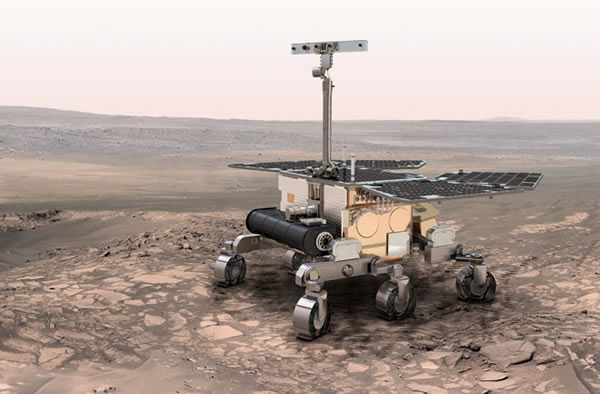Europe Probe's Sole Mission: Find Mars Life
ESA's ExoMars rover's sole mission will be to learn if life exists or ever existed on Mars.
While NASA's Mars rover Curiosity looks for habitats that could have supported microbial life, Europe is designing a sister rover that will take a more direct approach to determining if the planet most like Earth in the solar system has or ever had life.
"The goals of the two rovers are completely different," said Vincenzo Giorgio, vice president of exploration and space with Thales Alenia, which is the European Space Agency's prime contractor for its two-part ExoMars initiative.
"The ExoMars rover is going to be looking for life, drilling two meters below the Martian surface and having all the tools and instruments designed just for that scientific objective," Giorgio told Discovery News at the Paris Air Show, where his company signed a contract worth about $300 million for ExoMars work.
More than half of the money will go toward building an orbiter and a demonstration lander, which are scheduled to launch together in January 2016. The satellite, which will be outfitted with four science instruments, will take an initial stab at homing in on places where life might exist on Mars by searching for telltale gases in the atmosphere.
The probe, for example, will be able to distinguish between methane produced by biological activity and gases due to naturally occurring geology, said mission systems engineer Carlos Cassi.
"If there has been life on Mars there has been periods where gases have been produced by the presence of this life that would have gone into the atmosphere," Cassi told Discovery News.
The orbiter also will scout for other atmospheric gases, which is of interest to scientists and also for eventual human missions to Mars. Most importantly, the satellite will double as a communications relay for the 2018 rover, which will undertake a direct search life.
Technologies needed to enter into the thin Martian atmosphere, maneuver to the landing site (which has not yet been selected) and parachute down for a rocket-assisted landing will be tested during a practice run in 2016.
If the 2018 rover lands successfully and remains in good working order -- a notoriously difficult task that has been pulled off only seven times and only by the United States -- it will spend the next six months using a radar sounder to probe beneath the planet's surface for water, drilling up samples and running the rock powder through a series of on board chemical laboratories.
The experiments are intended to look for Martian bacteria and spores -- and provide clear evidence of the results.
"If there is any life and if we discover it, it will be unambiguous," Giorgio said. "On Viking everybody thought 'We found it, we found it,' but then nobody could prove it."
Overall, the European Space Agency plans to spend about 1.2 billion euros (about $1.6 billion) on the Mars Express mission. In addition, Russia will contribute two Proton rockets to launch the spacecraft, a rover landing system and two science instruments for the 2016 orbiter.
The Europeans originally hoped to partner with NASA instead of Russia on the project, but the United States canceled, citing lack of budget. NASA later announced plans for a follow-on Curiosity mission that would launch in 2020.(Jun 20, 2013 10:20 AM ET // by Irene Klotz)












